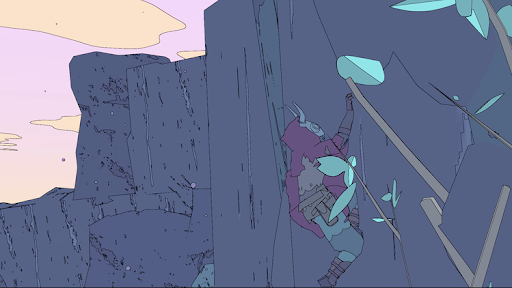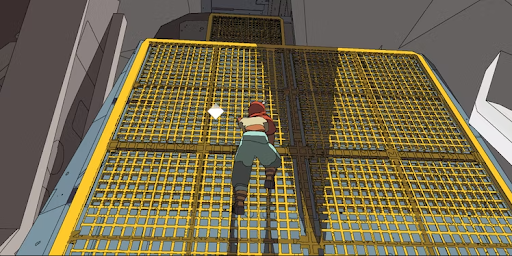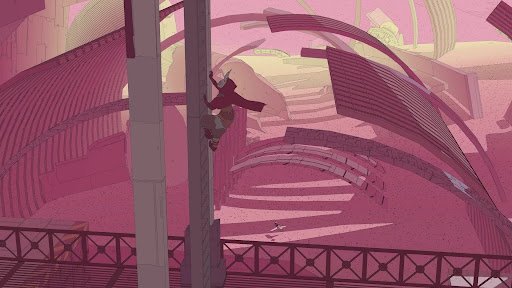My Personal Gliding: A Sable Retrospective
In September 2021, Shedworks launched their exploration focused third person adventure, Sable. Sable tells the story of a young girl of the same name who has finally reached the age required to go on her “Gliding” - a right of passage that takes her on a deep, personal journey across the seven regions of her world, Midden. Though its art style may not have been for everyone, I found it to be one of its strengths. Combining minimalist influences with striking uses of color that catches your eye immediately while characterizing the world in both dramatic and subtle ways. The canyons, mesas, deserts, and mountains that make up Midden emit their own mysteries and evoking their own types of emotions. I found the variety of emotions poignant to my experience as one that was comfortably lonely and serene. This unique story of self discovery captivated me - also happening to catch me right at a time where I was making choices regarding pathways in my own life. Much like Sable, I was taking leaps, trying things I had never done, as well as echoing sentiments of doubt and fear. It felt as if Sable and I were both on our paths of self discovery, weeding out everything to find out who we were. In some ways, we were on the same journey and I realized, in a way, that I was on my own personal gliding.
What “Makes” Sable
Before jumping into the ways I connected with Sable and her journey, I think it’s important to dive into what made this game “click” and become such a gem to me. Despite my love for the medium, it’s not often I feel moved in serious ways by a video game. For me, Sable simultaneously managed to feel familiar yet very foreign with its approaches to its presentation and mechanics. Most notably, the decision to exclude combat and even death from the game. I found this decision to forgo these mechanics to be one that steeped me more into the lands themselves and ultimately works for the overall experience that Sable set out to deliver. The time I could’ve spent in combat was instead spent familiarizing myself with landmarks, platforming, and completing puzzles. Sable as a whole felt like expressionism art. Conveying its world with minimalist art direction and presenting familiar mechanics like gliding, climbing, and looking at the compass in creative ways that all felt within its artistic wheelhouse. What made this feel so different to me when compared to other artistically driven games though is the art. Sable’s presentation is purposeful and isn’t purely for the wow factor. The art of Sable perfectly captures the tone of the world and story as a whole. It invokes what Sable feels; what Shedworks wanted me to feel. Sable distorts its world through the lens of its art direction to invoke those feelings; the defining trait of expressionism. Granted, games of all kinds do this, and one could argue that all games are expressionism. However, I just can’t overstate how much Sable managed to do by presenting so little.
For instance, the way the compass works is simple, but added meaningful texture to my experience. Instead of opting for a traditional compass and mini-map or even a directional compass at the top or bottom of the screen, Shedworks instead chose to have Sable literally pull out her compass and check it. Doing so brings up a representation of it around her displaying any objectives, personal waypoints, and the cardinal directions in a massive display right in the center of the screen. Not only was this something I found to be visually unique, adding to the quirky identity of the game, but it added a layer of immersiveness. To find myself lost in a seemingly infinite sea of dunes only to climb the nearest rock formation, see something on the horizon, and physically pull out my compass to catch my bearings felt so grounded and purposeful. I wasn’t going to starve, dehydrate, or be attacked by enemies because there were none, but the isolating feeling of being lost in an unknown world prompted action. This action felt organic, real, and acted as a way for me to uncover the mysteries and truths of Midden myself as opposed to the game laying things out on a straight a narrow path.
The story of Sable is just that: the story of our titular character's journey. The people she meets, the choices she makes, and the results of those choices eventually lead her the journey's end. However, this main story didn’t often, if ever, intersect with the story delivered from the side content in the game. Content that when investigated started to paint a more detailed picture about what really went on to make Midden, it’s societies, and it’s people what they were. Whether it be atop the Crystal Plateau far above the black sands of Hakoa or deep beneath the sands within The Watch, the locations within Midden held their own truths and histories. I won’t spoil any of the reveals the game has hidden, but these points of interest helped perpetuate the organic cycle of exploring. The new found knowledge of the world that exploring delivered also provided a sense of accomplishment during my journey. When paired with the climbing mechanics, it truly made me feel as if I was exploring this world for myself.
Climbing works very similarly to The Legend of Zelda: Breath of The Wild in that Sable can make her way up mostly every structure in the world and her ability to ascend is dictated by her stamina bar. This depletion of stamina started to turn every structure I scaled into a puzzle of its own. This made me observe all the angles to see just how I might be able to get to the top of a structure or stuck on a particular ledge without depleting my stamina and falling all the way back down just to restart. Some of what Sable ends up scaling in this game can be a few minutes worth of climbing, analyzing, and either properly or improperly executing. Though Shedworks chose to forgo death in the game, you still feel the weight and frustration that comes from a misstep or poorly timed glide.
While the act of climbing and various puzzles requires you to strategically use what stamina you have, there is a way to increase Sable’s stamina through odd offerings called chum eggs. These eggs can be found all over Midden. These are then collected in groups to be delivered back to the chum queen, a massive telepathic worm, who then grants a significant stamina increase. This gameplay loop further incentivized the already organic exploration of the game and created what, to me, felt like a perfect balance in challenge. Even though everyone will likely collect at their own pace, for me these increases in stamina seemed to come right at the perfect times. As I would enter new regions, the obstacles necessary to climb would become more intensive. This allowed the increase in stamina to feel significant on older obstacles and even help me get up previously unscalable ones, while also feeling like I was still being challenged by the new discoveries in recently entered regions.
Having to restart a climb can be frustrating, but it's in the determination to avoid these restarts that an intimacy with obstacles started to form. I came to understand every nook and cranny of the structure in question. Where are the holds? Which protrusion can let me stand up in order to give me a stamina recharge? Can I glide to a different structure to get a new angle on what I'm trying to ascend? While it’s never overwhelmingly complicated, every decision that went into climbing started to become much more calculated. I started to intimately get to know the structures I was climbing. This approach to architecture evoked feelings when it broke horizons and played against game mechanics. It began to make sense upon realizing that Sable’s creative director, Gregorios Kythreotis, had a background in architectural design.
When speaking to Greg about his inspirations and creative processes, he mentioned how the evocative nature of Midden came to be. Starting mainly with combining architectural inspirations like the works of Carlo Scarpla, and different architectural styles like vernacular and tent architecture with world building.
In terms of actual process, I would say it impacted my personal approach to world building and developing the history of the world, The ways in which I tried to approach how people in this world would treat materials, how they would take advantage of sand and rock and value water as well as how they would reappropriate materials from the fallen metal ships strewn across the landscape. We definitely wanted to convey specific feelings with different types of environments, but the broader feelings we wanted players to feel was that of awe, melancholy, discovery and curiosity. This was something we tried to imbue in every location, the approach players take as well as the interactions they have within the spaces themselves.
The Music of Midden
Among the handful of hours I spent jetting across the hand drawn dunes on my glider, I was always met with what felt like the intended feelings thanks to an absolutely stellar soundtrack by Japanese Breakfast. Ranging from lighthearted, to dark and mysterious feeling, the soundtrack does a remarkable job at further characterizing the world and drenching various locations in ambient moods. This played a critical role in really letting me settle into these moments where I felt like I was existing in Midden. Taking in my surroundings and pushing further into Sable’s journey allowed myself to be enamored by the beauty, simplicity and scale of it all.
Regions all have their own themes for both the day and night, which in conjunction with the palette swaps that the landscapes get, help them take on whole new moods. The daytime theme for The Ewer, the region that Sable’s own Ibex tribe calls home, invoked her wondrous curiosity during the early stages of the game. Conversely, the daytime theme for the Hakoa region emanated a brooding, ambient sci-fi tone that captured the darker presentation of the region. Hokoa’s night theme, while carrying a much more melancholic tone, still plugs in beautifully to the overall musical presentation of the region. The symphony of sound grew a thought in me that something other worldly might’ve happened eons ago to make Hokoa’s landscapes what they were. This feeling is especially present within the ruins and temples found in the world.
Within the tracks of the overworld, the tone is set with precision through their melodic feel. Tracks like Pyraustas Ruins have a haunting ambience to them, for example. Oftentimes to enter these places of interest I'd need to get through obstacles, solve puzzles, or a combination of the two. This challenge to gain entry, paired with that haunting ambience, really sold me on the idea that Sable was the first person to set foot in these places since whoever or whatever built them left. This added a level of gravitas to exploring spaces like these and created a mood all to itself. All of these moods can vary greatly from region to region and even just from day to night like in Hokoa. However, no matter where I happened to find myself they still maintained the mysterious and curious nature that the team at Shedworks made sure permeated the game as a whole.
The Gliding of Life
I couldn’t tell you why, but from a young age I've always found deserts and the surrounding landscapes alluring. With this, I felt naturally drawn to Sable just off the strength of its setting alone. However, the circumstances around my time with the game and the period of my life that I spent playing it seemed to perfectly align in a way that I couldn't have foreseen.
As I mentioned before, the path to self discovery felt like something that both Sable and myself were on together. However, it didn’t start this way. In the beginning of my playthrough, I thought nothing of the odyssey that I had set out on. What was for certain, however, was something that existed outside of the game. My anxiety regarding what I was doing with myself and the choices I had made in my life up to that point; from course correcting myself from self destruction to uncovering an old passion for games, and going back to school to even writing for this very site. This was all new and exciting, but also foreign and full of the dreaded “what if’s.” To my surprise these “what if’s” seemed to fade away in the face of the vast landscapes of Midden, and so those same landscapes became my escape for the foreseeable future.
What started as a way to unwind and get away from the stresses of life started to develop into a desire to simply be in Midden. The more time I spent in Midden with Sable, the more time I got to sit with her situation and subsequently make sense of my own. Unlike Sable, I wasn't wandering deserts on a hoverbike or discovering ancient structures. Instead, I was venturing into the world in ways I hadn't before. I felt I was sharing this experience of being without a place in the world while finding one that best suited me. An experience I still feel as though I’m having, however, the lens of which I view it through has changed dramatically.
This odd “shared” experience ultimately helped me stumble upon realizations, answers, and remedies to my personal questions and battles at the time. Though, it wasn’t until one particular night while playing that everything clicked. The game, my personal troubles, the questions I was desperately asking myself - it all just suddenly made sense. The epiphany I had was atop a monolithic mesa in the Sansee region, far out, above the dunes crafted by Shedworks. As an isolated glider with a foreign world at their fingertips, I found solace in my isolation both virtual and non-virtual. The solace helped me realize that purpose and destiny aren’t pre-determined, but rather crafted. Found along the journey, far out in the “foreign” world beneath unturned stones disguised as fear and through dark mysterious places we’ve labeled as doubt.
It was with this realization that I started to feel less insecure regarding my position in life and more grateful for the fact that I was even granted it. While imposter syndrome and anxiety could still rear their heads from time to time, I now had a framework to view myself within that made sense. There’s no timeline for anyone, and we all have our own journeys to take - our own gliding’s to go on. For the first time in a long time I felt as though I was something more than just a lost soul in the world. With an acceptance for the unknown trajectory and an understanding that, just like Sable, we all find our paths in time. It’s just important that we don’t discredit the experiences we have along the way.
By Justin Hyde








